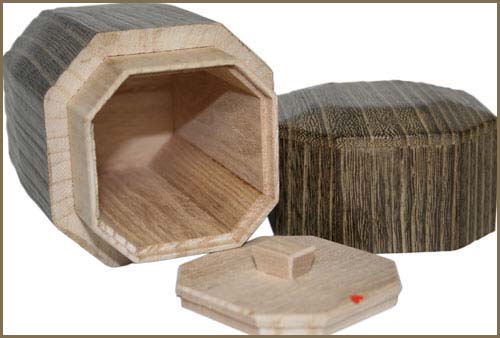. Legends and Tales from Japan 伝説 - Introduction .
:::::::::::::::::::::::::::::::::::::::::::::::::::::::::::::::::::::::::::::::::::::::::::::::::::::::::::::::::::::::::::::::::::::::::::::::::::::::::::::::::::::::::::
kiri 桐 paulownia wood art
Paulownia tomentosa - Paulownia, Royal Paulownia, Princess Tree, Kiri
Most famous are
. kiridansu, kiri tansu 桐箪笥 chest from paulownia wood .
- Introduction -
. aburagiri 油桐 "oil-paulownia", Tung tree (Vernicia fordii).
..............................................................................................................................................
- quote -
- - - - - Paulownia - - - - -
Color/Appearance:
Heartwood typically a pale grayish brown, sometimes with a reddish or purplish hue. Pale white sapwood not clearly demarcated from heartwood. Overall appearance (both the wood and the tree itself) is not too unlike Catalpa, another lightweight and porous hardwood.
Grain/Texture:
Grain is generally straight, with a coarse, uneven texture. Very large pores give Paulownia a striped, porous look.
Endgrain:
Ring-porous, occasionally semi-ring-porous; 3-5 rows of very large earlywood pores, medium to small latewood pores; tyloses common; growth rings distinct; rays visible without lens; parenchyma aliform (winged and lozenge), confluent, and banded.
- snip -
Workability:
Given its straight grain and light weight, Paulownia is extremely easy to work. However, due to a high silica content in some trees, the wood can have a strong blunting effect on cutting edges. Takes a wide variety of glues, stains, and finishes well.
Common Uses:
Plywood, veneer, furniture, boxes, millwork/siding, musical instruments (electric guitar bodies), clogs, carvings, and other small specialty items.

Paulownia (sealed)
- - - Comments:
The other Balsa.
Paulownia is used in applications where a lightweight (yet proportionately strong) wood is needed. It’s widely used in Japan for construction of the koto (a stringed musical instrument), as well as other household items, where the wood is referred to as Kiri. Paulownia is one of the fastest growing trees in the world, capable of growth rates of well over seven feet per year as a seedling! But while it’s highly appreciated and cultivated in Asia, Paulownia has come to be considered an invasive species in the United States.
Paulownia was named after Queen Anna Pavlovna of Russia (1795-1865), and is sometimes called Royal Paulownia or Princess Tree.
- source : wood-database.com -
:::::::::::::::::::::::::::::::::::::::::::::::::::::::::::::::::::::::::::::::::::::::::::::::::::::::::::::::::::::::::::::::::::::::::::::::::::::::::::::::::::::::::::
. gangu 玩具 伝説, omochcha おもちゃ toy, toys and legends .
- Introduction -
kiri gangu 桐玩具 toys from paulownia wood

tsumiki 積木
- look at more of the toys -
- source : KIRIYchan 桐小物 -
:::::::::::::::::::::::::::::::::::::::::::::::::::::::::::::::::::::::::::::::::::::::::::::::::::::::::::::::::::::::::::::::::::::::::::::::::::::::::::::::::::::::::::
- ABC - List of kiri art from the Prefectures
..............................................................................................................................................
. . . . . . . . . . Fukushima
. Aizu kiri koma, kirikoma 会津桐駒 / 桐馬 horse from paulownia wood .
..............................................................................................................................................
. . . . . . . . . . Ishikawa
Paulownia Handicrafts
The kirihibachi 桐鉢, a traditional Japanese hand/room warmer made of paulownia (also called princess tree), was nationally famous before the heating instrument using oil or electricity appeared. The main reasons were that it was easy to obtain the material in those days and that a lacquer work technique used for the kirihibachi attracted people.
Presently, paulownia vases, cake trays, and small drawers are manufactured with splendid lacquer work performed while making use of the grain of the paulownia.
- source : kanazawa-tourism.com -

. hibachi 火鉢 Brazier, hand warmer .

金沢桐工芸とは
- Look at more samples how to process paulownia wood :
- source : iwamoto-kiyoshi-shouten -
..............................................................................................................................................
. . . . . . . . . . Kumamoto
. okin jo ningyoo, O-Kin おきん女人形 / おきん女人形 The Girl O-Kin .
from Hinagu Hot Spring 日奈久温泉
:::::::::::::::::::::::::::::::::::::::::::::::::::::::::::::::::::::::::::::::::::::::::::::::::::::::::::::::::::::::::::::::::::::::::::::::::::::::::::::::::::::::::::
kirizaiku, kiri zaiku 桐細工

tea container from Aizu paulownia
. . . CLICK here for Photos !
. Reference .
- - - #kiri #paulownia #kiriko - - - - -
:::::::::::::::::::::::::::::::::::::::::::::::::::::::::::::::::::::::::::::::::::::::::::::::::::::::::::::::::::::::::::::::::::::::::::::::::::::::::::::::::::::::::::
kiriko 桐粉 powder of ground paulownia wood
. Nasu kushi deko 那須串人形 head dolls .
Many are made from the wood of paulownia (tooso ningyoo 桐塑人形 ). The wood is made to powder (kiriko 桐粉) and then kneaded with natural glue. When the form is done, it is whitened by layering it with gofun whitewash powder. Finally the colors are added.
.......................................................................
kiri no ko ningyoo 桐の粉人形 doll from paulownia wood powder
- The 12 zodiac animals are available
- source : f-ippindo.com/shoppin -

Kirinoko Ningyokan Aizu
会津桐の木片をラーメン粉粘土に練り込み、一体一体手 びねりで作るのが桐のこ人形です.
- source : aizu-kinomoto.com/dollhouse -
- reference -
:::::::::::::::::::::::::::::::::::::::::::::::::::::::::::::::::::::::::::::::::::::::::::::::::::::::::::::::::::::::::::::::::::::::::::::::::::::::::::::::::::::::::::
. Join the MINGEI group on facebook ! .
. Regional Folk Toys from Japan .
. Japan - Shrines and Temples .
. Tohoku after the BIG earthquake March 11, 2011
[ . BACK to WORLDKIGO . TOP . ]
[ . BACK to DARUMA MUSEUM TOP . ]
:::::::::::::::::::::::::::::::::::::::::::::::::::::::::::::::::::::::::::::::::::::::::::::::::::::::::::::::::::::::::::::::::::::::::::::::::::::::::::::::::::::::::::
No comments:
Post a Comment